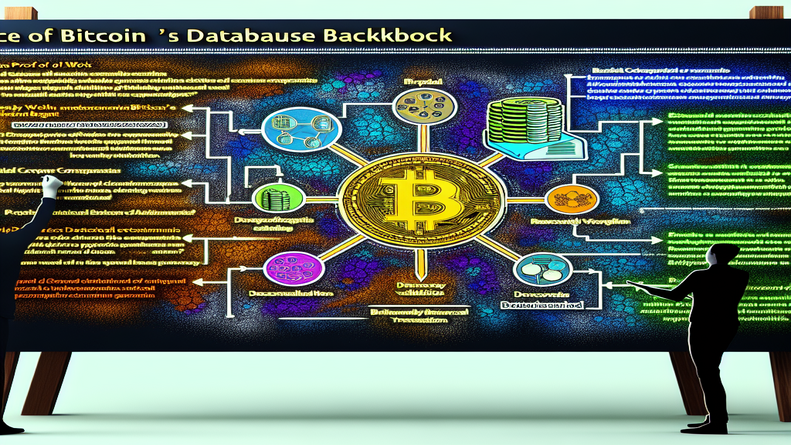Get ready, brace yourself. Reading this might enrage and confound you, it might confuse you, you might even get mad enough to punch your screen (don’t do that.) Consider this a trigger warning.
Understanding Bitcoin’s Core: The Database Paradigm
Bitcoin is a database. Period. That is what it is. The blockchain is a database for storing past updates to be able to reproduce the current state of that database, the UTXO set. The entire Bitcoin protocol is structured around the database—defining what constitutes a valid entry, delineating the process for adding entries, and filtering invalid updates. Every transaction, every mined block, and every script in Bitcoin essentially boils down to interactions with this extensive database. The complex code, the cryptographic proofs, and the trustless exchange of digital assets all serve to maintain the integrity and synchronization of this global decentralized database.
The Robustness of Authentication: Scripting Bitcoin’s Security
Bitcoin’s scripting language is not some ancillary feature; it is the cornerstone of the network’s security. It acts as the authorization mechanism dictating who can write to the blockchain. This scripting language defines the conditions under which the existing data can be altered or new data can be added, ensuring a secure and controlled transaction process. Miners play a vital role in this ecosystem as the custodians who can add new entries on the blockchain without prior conditions, albeit with different sets of constraints. While they can create these entries, they must do so by solving complex cryptographic puzzles which essentially verify the right to append the blockchain—a process known as proof-of-work.
The Ingenious Mechanics of Proof-of-Work
 Proof-of-work (POW) is the ingenious mechanism that underpins Bitcoin’s decentralized nature. POW isn’t just about solving puzzles; it’s about proving the commitment of resources towards processing updates to the database. It secures the right for an entity to endorse a new block to the chain, ensuring that all network participants can come to a consensus on a single version of the database. Think of it as a form of democratic validation where anyone can participate, but they must prove their dedication to the network by expending real-world resources—and thus cannot do so trivially or maliciously without incurring significant costs.
Proof-of-work (POW) is the ingenious mechanism that underpins Bitcoin’s decentralized nature. POW isn’t just about solving puzzles; it’s about proving the commitment of resources towards processing updates to the database. It secures the right for an entity to endorse a new block to the chain, ensuring that all network participants can come to a consensus on a single version of the database. Think of it as a form of democratic validation where anyone can participate, but they must prove their dedication to the network by expending real-world resources—and thus cannot do so trivially or maliciously without incurring significant costs.
A Network United: The Peer-to-Peer Revelation
The peer-to-peer network is not an optional add-on but the essential infrastructural fabric holding Bitcoin together. This network is dedicated to transmitting proposed updates (transactions) and finalized updates (blocks) across all nodes, guaranteeing that each node’s copy of the database is consistent with the others’. Nodes assume the role of gatekeepers, verifying the authenticity and validity of transactions before they’re woven into the blockchain. This system not only prevents invalid database entries but also reinforces the consensus on the database state—solidifying trust without the need for centralized authority.
Unpacking Blockchain: More Than a Ledger
Bitcoin’s blockchain isn’t just a ledger; it is a testament to the power of distributed consensus. Each block, each transaction, and each validation supports the framework of a database that is both robust and delicate in its equilibrium. The technology is revolutionary not because it crafted something entirely unheard of but because it re-envisioned the database’s role in a decentralized context. Some advocate for Bitcoin’s role strictly as a financial instrument, while others are eager to explore diverse applications within the existing rules. Both perspectives stem from understanding Bitcoin as a flexible, powerful database that continues to evolve.
Bitcoin: A Database That Redefined Trust and Ownership
In conclusion, Bitcoin transgresses beyond the boundaries of traditional databases. It is a socio-technological phenomenon—a decentralized database that redefines concepts of trust, ownership, and collaboration. As the world continues to debate its various applications, it remains unquestionable that at its heart, Bitcoin is a radical reimagining of the database, positioned at the frontiers of our digital future.Are you prepared to continue this conversation and explore the myriad potentials of Bitcoin’s database-driven revolution? Join me and let’s delve deeper into this transformative technology that shakes the very foundation of conventional databases and paves the way for innovation in the digital age. Your next step begins with a click—connect with me on LinkedIn 🚀🌟.
